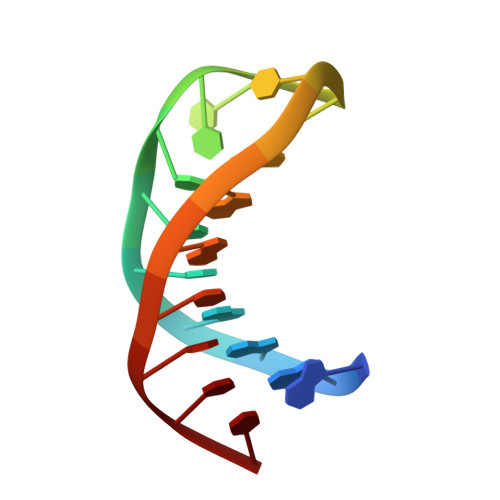Structural basis for poor uracil excision from hairpin DNA. An NMR study.
Ghosh, M., Rumpal, N., Varshney, U., Chary, K.V.(2002) Eur J Biochem 269: 1886-1894
- PubMed: 11952790
- DOI: https://doi.org/10.1046/j.1432-1033.2002.02837.x
- Primary Citation of Related Structures:
1IDX, 1II1 - PubMed Abstract:
Two-dimensional NMR and molecular dynamics simulations have been used to determine the three-dimensional structures of two hairpin DNA structures: d-CTAGAG GATCCUTTTGGATCCT (abbreviated as U1-hairpin) and d-CTAGAGGATCCTTUTGGATCCT (abbreviated as U3-hairpin). The 1H resonances of both of these hairpin structures have been assigned almost completely. NMR restrained molecular dynamics and energy minimization procedures have been used to describe the three-dimensional structures of these hairpins. This study and concurrent NMR structural studies on two other d-CTAGAGGA TCCTUTTGGATCCT (abbreviated as U2-hairpin) and d-CTAGAGGATCCTTTUGGATCCT (abbreviated as U4-hairpin) have shed light upon various interactions reported between Echerichia coli uracil DNA glycosylase (UDG) and uracil-containing DNA. The backbone torsion angles, which partially influence the local conformation of U12 and U14 in U1 and U3-hairpins, respectively, are probably locked in the trans conformation as in the case of U13 in the U2-hairpin. Such a stretched-out backbone conformation in the vicinity of U12 and U14 is thought to be the reason why the Km value is poor for U1- and U3-hairpins as it is for the U2-hairpin. Furthermore, the bases U12 and U14 in both U1- and U3-hairpins adopt an anti conformation, in contrast with the base conformation of U13 in the U2-hairpin, which adopts a syn conformation. The clear discrepancy observed in the U-base orientation with respect to the sugar moieties could explain why the Vmax value is 10- to 20-fold higher for the U1- and U3-hairpins compared with the U2-hairpin. Taken together, these observations support our interpretation that the unfavourable backbone results in a poor Km value, whereas the unfavourable nucleotide conformation results in a poor Vmax value. These two parameters therefore make the U1- and U3-hairpins better substrates for UDG compared with the U2-hairpin, as reported earlier [Kumar, N. V. & Varshney, U. (1997) Nucleic Acids Res. 25, 2336-2343.].
Organizational Affiliation:
Department of Chemical Sciences, Tata Institute of Fundamental Research, Colaba, Mumbai, India.














